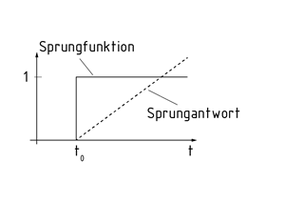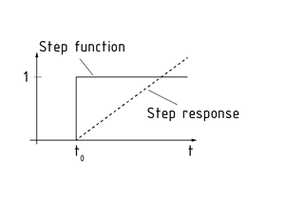
Seleccione uno
o más idiomas
0,1,3
- Alemán
- Inglés
- Chino
- Español
Elemento I

El controlador I o elemento I en un controlador indica cómo un elemento de transferencia responde en un sistema de control de bucle cerrado. Los controladores I muestran una respuesta integradora y son comparativamente lentos, pero no se produce un error de control si no hay interferencia. La ocurrencia de las variables de perturbación resulta en una desviación de control e que el controlador I solo puede corregir de forma relativamente lenta debido a la inercia.
La respuesta de paso del elemento I es una línea recta que surge con el tiempo con la pendiente ${{K}_{I}}=\frac{\Delta a}{\Delta t}$. La pendiente $K_I$ también se llama coeficiente de acción integral, constante de transformación o factor de amplificación del elemento I. En el caso de una desviación de control constante, la salida del elemento I se incrementa linealmente a partir de un valor inicial hasta su límite.
Los elementos I permiten una corrección completa sin un error de control y son, por lo tanto, adecuados para controlar sistemas complejos. Se combinan a menudo con un elemento P o PD para este propósito.
Respuesta de paso de un controlador I
I-Glied

Der I-Regler beziehungsweise das I-Glied in einem Regler bezeichnet das Verhalten eines Übertragungsgliedes in der Regelungstechnik. I-Regler weisen ein integratives Übertragungsverhalten auf, sind vergleichsweise langsame Regler und besitzen im störungsfreien Fall jedoch keine Regelabweichung. Durch ein Auftreten von Störgrößen tritt eine Regeldifferenz e zutage, die der I-Regler aufgrund Trägheit erst relativ langsam ausregeln kann.
Die Sprungantwort eines I-Gliedes ist eine mit der Zeit ansteigende Gerade mit der Steigung ${{K}_{I}}=\frac{\Delta a}{\Delta t}$. Die Steigung KI wird dabei auch als Integrierbeiwert, Übertragungskonstante oder Verstärkungsfaktor des I-Gliedes bezeichnet. Bei einer konstanten Regeldifferenz steigt der Ausgang des I-Gliedes von einem Anfangswert linear bis zu seiner Begrenzung an.
Aufgrund vollständigen Ausregelung ohne Regelabweichung eignen sich I-Glieder zur Regelung komplexer Systeme. Oftmals wird hierzu auf eine Kombination mit einem P-Glied oder einem PD-Glied zurückgegriffen.
I element

The I controller or I element in a controller indicates how a transfer element responds in a Closed-loop control system. I controllers exhibit an integrative response and are comparatively slow but there is no control error if there is no interference. The occurrence of disturbance variables results in a control deviation e that the I controller can only correct relatively slowly due to inertia.
An I element's Step response is a straight line that rises over time with the slope ${{K}_{I}}=\frac{\Delta a}{\Delta t}$. The slope KI is also called the integral-action coefficient, the transfer constant or the amplification factor of the I element. In the case of a constant control deviation, the I element's output increases linearly from an initial value to its limit.
I elements enable full correction without a control error and are therefore suitable for controlling complex systems. They are often combined with a P or PD element for this purpose.
积分元件

积分控制器或控制器中的积分元件表示的是传递元件在闭环控制系统的响应方式。如果没有干扰,积分控制器的反应虽然比较缓慢,但不会有控制误差。如果干扰变量产生了控制偏差 e ,那么由于惯性的存在,积分控制器进行的矫正将相对缓慢。
积分元件的阶跃响应将是一条随时间上升的直线,其斜率为 ${{K}_{I}}=\frac{\Delta a}{\Delta t}$ 。斜率 $K_I$ 因此又被称为积分元件的积分作用系数、转移常数或放大因子。在恒定的控制偏差的情况下,积分元件的输出会从初始值以线性的方式增加到其极限值。
积分元件可在没有控制误差的情况下实现完全校正,因此适用于复杂系统的控制。在进行该复杂系统的控制的时候,积分元件经常与比例或比例微分元件相结合使用。
积分控制器的阶跃响应
近义词
积分控制器
积分元件
积分作用系数
转移常数
放大因子
